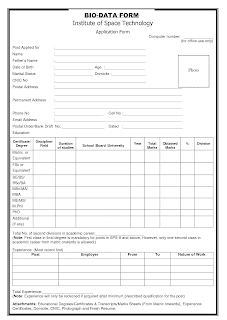 |
| Biodata Format |
A resume or biodata is a document that primarily aims to “sell” an individual by pitching his or her professional and technical skills and experiences to a company that may need it. Hiring companies often see and judge the biodata before the candidate; thus, it is important to pay attention when it comes to crafting it as much as one prepares for an interview. The biodata should stand in itself, but that does not mean that you, the jobseeker, should put everything and anything about you in it. There are many types of biodata, the formats differing as each type emphasizes one skill or experience over the other. It is best to adopt a biodata format that will highlight your best assets.
Hiring companies are always on the look-out for the best people, and chances are, they would just skim through your biodata if the format looks like it is a ten-page short story. So, even if you are a fresh graduate or a suddenly jobless worker, a well-written biodata will get you considered for that interview and hopefully land you the job. But how does well-written look like? First, one should pay attention to the biodata format. The biodata format systematically lays out your personal, educational, and professional and/or technical information while focusing on your best assets. In the general biodata format, the first part should contain your personal basic information as well as your contact information. Putting two to three sentences about your general career objective will give your prospective employer an idea whether they can help you reach that goal.
The next section may include your educational qualifications, previous work experience, and major achievements or extracurricular activities. While biodata formats may vary, one should choose which of the above mentioned can be emphasized as his/her strength. In many cases, work experience is highlighted as it helps showcase the individual’s skills, roles and contributions to his/her previous organization. For fresh graduates, educational qualifications, achievements, and extracurricular activities give an opportunity to play up their accomplishment and roles in organizations they had participated in.
The last section should be about more on your personal information, such as technical skills. List all skills relevant to your profession and that may be useful to your prospective employer. Hobbies and interest are optional entries, but some employers appreciate and even judge how an individual spends his/her free time.
While the biodata format should not be a rigid structure, it should be a convenient system that can be turned around to serve the purpose of the jobseeker. In addition, use a clean paper, legible font styles (ex. Times New Roman, Arial) and size (16 for heading, 12 for text), and minimal design to maintain a crisp, professional biodata format.
Hiring companies are always on the look-out for the best people, and chances are, they would just skim through your biodata if the format looks like it is a ten-page short story. So, even if you are a fresh graduate or a suddenly jobless worker, a well-written biodata will get you considered for that interview and hopefully land you the job. But how does well-written look like? First, one should pay attention to the biodata format. The biodata format systematically lays out your personal, educational, and professional and/or technical information while focusing on your best assets. In the general biodata format, the first part should contain your personal basic information as well as your contact information. Putting two to three sentences about your general career objective will give your prospective employer an idea whether they can help you reach that goal.
The next section may include your educational qualifications, previous work experience, and major achievements or extracurricular activities. While biodata formats may vary, one should choose which of the above mentioned can be emphasized as his/her strength. In many cases, work experience is highlighted as it helps showcase the individual’s skills, roles and contributions to his/her previous organization. For fresh graduates, educational qualifications, achievements, and extracurricular activities give an opportunity to play up their accomplishment and roles in organizations they had participated in.
The last section should be about more on your personal information, such as technical skills. List all skills relevant to your profession and that may be useful to your prospective employer. Hobbies and interest are optional entries, but some employers appreciate and even judge how an individual spends his/her free time.
While the biodata format should not be a rigid structure, it should be a convenient system that can be turned around to serve the purpose of the jobseeker. In addition, use a clean paper, legible font styles (ex. Times New Roman, Arial) and size (16 for heading, 12 for text), and minimal design to maintain a crisp, professional biodata format.












0 komentar: